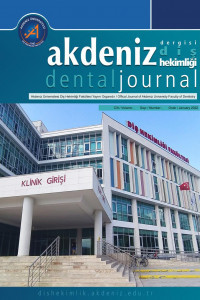THE EFFECT OF GLIDE PATH ESTABLISHMENT ON STRESS GENERATION DURING INSTRUMENTATION: AN ACOUSTIC ANALYSIS
Glide path, WaveOne Gold Glider, stress generation, acoustic analysis
___
- 1. Cheung GS, Liu CS. A retrospective study of endodontic treatment outcome between nickel-titanium rotary and stainless steel hand filing techniques. J Endod. 2009;35(7):938-43.
- 2. Peters OA. Current challenges and concepts in the preparation of root canal systems: a review. J Endod. 2004;30(8):559-67.
- 3. Gambill JM, Alder M, del Rio CE. Comparison of nickel-titanium and stainless steel hand-file instrumentation using computed tomography. J Endod. 1996;22(7):369-75.
- 4. Parashos P, Messer HH. Rotary NiTi instrument fracture and its consequences. J Endod. 2006;32(11):1031-43.
- 5. Loizides AL, Kakavetsos VD, Tzanetakis GN, Kontakiotis EG, Eliades G. A comparative study of the effects of two nickel-titanium preparation techniques on root canal geometry assessed by microcomputed tomography. J Endod. 2007;33(12):1455-9.
- 6. Ounsi HF, Salameh Z, Al-Shalan T, Ferrari M, Grandini S, Pashley DH, et al. Effect of clinical use on the cyclic fatigue resistance of ProTaper nickel-titanium rotary instruments. J Endod. 2007;33(6):737-41.
- 7. Berutti E, Chiandussi G, Gaviglio I, Ibba A. Comparative analysis of torsional and bending stresses in two mathematical models of nickel-titanium rotary instruments: ProTaper versus ProFile. J Endod. 2003;29(1):15-9.
- 8. Roland DD, Andelin WE, Browning DF, Hsu GH, Torabinejad M. The effect of preflaring on the rates of separation for 0.04 taper nickel titanium rotary instruments. J Endod. 2002;28(7):543-5.
- 9. Atmeh AR, Watson TF. Root dentine and endodontic instrumentation: cutting edge microscopic imaging. Interface Focus. 2016;6(3):20150113.
- 10. Pilo R, Metzger Z, Brosh T. Strain Distribution in Root Surface Dentin of Maxillary Central Incisors during Lateral Compaction. PLoS One. 2016;11(5):e0156461.
- 11. Patino PV, Biedma BM, Liebana CR, Cantatore G, Bahillo JG. The influence of a manual glide path on the separation rate of NiTi rotary instruments. J Endod. 2005;31(2):114-6.
- 12. Peters OA, Peters CI, Schonenberger K, Barbakow F. ProTaper rotary root canal preparation: assessment of torque and force in relation to canal anatomy. Int Endod J. 2003;36(2):93-9.
- 13. Sattapan B, Nervo GJ, Palamara JE, Messer HH. Defects in rotary nickel-titanium files after clinical use. J Endod. 2000;26(3):161-5. 14. Ha JH, Park SS. Influence of glide path on the screw-in effect and torque of nickel-titanium rotary files in simulated resin root canals. Restor Dent Endod. 2012;37(4):215-9.
- 15. Kwak SW, Ha JH, Cheung GS, Kim HC, Kim SK. Effect of the Glide Path Establishment on the Torque Generation to the Files during Instrumentation: An In Vitro Measurement. J Endod. 2018;44(3):496-500.
- 16. Berutti E, Alovisi M, Pastorelli MA, Chiandussi G, Scotti N, Pasqualini D. Energy consumption of ProTaper Next X1 after glide path with PathFiles and ProGlider. J Endod. 2014;40(12):2015-8.
- 17. Jamleh A, Adorno CG, Ebihara A, Suda H. Effect of nickel titanium file design on the root surface strain and apical microcracks. Aust Endod J. 2016;42(1):25-31.
- 18. Burklein S, Stuber JP, Schafer E. Real-time dynamic torque values and axial forces during preparation of straight root canals using three different endodontic motors and hand preparation. Int Endod J. 2019;52(1):94-104.
- 19. Plotino G, Grande NM, Testarelli L, Gambarini G. Cyclic fatigue of Reciproc and WaveOne reciprocating instruments. Int Endod J. 2012;45(7):614-8.
- 20. Zinovy Nazrchuk VS S. Acoustic Emission Methodology and Application. 2017: . 21. Berutti E, Negro AR, Lendini M, Pasqualini D. Influence of manual preflaring and torque on the failure rate of ProTaper rotary instruments. J Endod. 2004;30(4):228-30.
- 22. Jamleh A, Komabayashi T, Ebihara A, Nassar M, Watanabe S, Yoshioka T, et al. Root surface strain during canal shaping and its influence on apical microcrack development: a preliminary investigation. Int Endod J. 2015;48(12):1103-11.
- 23. Tokita D, Ebihara A, Nishijo M, Miyara K, Okiji T. Dynamic Torque and Vertical Force Analysis during Nickel-titanium Rotary Root Canal Preparation with Different Modes of Reciprocal Rotation. J Endod. 2017;43(10):1706-10.
- 24. Pereira ES, Singh R, Arias A, Peters OA. In vitro assessment of torque and force generated by novel ProTaper Next Instruments during simulated canal preparation. J Endod. 2013;39(12):1615-9.
- 25. Kim HC, Cheung GS, Lee CJ, Kim BM, Park JK, Kang SI. Comparison of forces generated during root canal shaping and residual stresses of three nickel-titanium rotary files by using a three-dimensional finite-element analysis. J Endod. 2008;34(6):743-7.
- 26. Kwak SW, Ha JH, Cheung GS, Kim SK, Kim HC. Comparison of In Vitro Torque Generation during Instrumentation with Adaptive Versus Continuous Movement. J Endod. 2019;45(6):803-7.
- 27. Jayant Sirohi IC. Fundamental Understanding of Piezoelectric Strain Sensors. Journal of Intelligent Material Systems and Structures. 2000.
- 28. Preumont A. Vibration Control of Active Structures An Introductıon. 3 ed: Springer; 2011.
- Başlangıç: 2022
- Yayıncı: Akdeniz Üniversitesi
Üç Varyasyonuyla Submandibular Tükürük Bezi Taşları: Olgu Serisi
Damla KIRICI, Kayra KURŞUN, Ertuğrul KARATAŞ
Diagnostik İkilem- Kapiller Hemangiom Yada Granuloma Gravidarum : Olgu Sunumu
Bilay STEVANOVIC SANCAR, Ali RASAT, Sevcihan GÜNEN YILMAZ
The Developing Technology of Artificial Intelligence in Endodontics: A Literature Review
Simay KOC, Turgut FELEK, Damla ERKAL, Kürşat ER
Rümeysa ŞENDİŞÇİ, Bilay STEVANOVIC SANCAR, Ali EKİNCİ, Sevcihan GÜNEN YILMAZ
Dı̇ş Hekı̇mlı̇ğı̇ Pratı̇ğı̇nde Dental Bleaching: Öğrencı̇ Bakış Açısı
Sevgi EKİCİ, Rıdvan YAKAR, Yusuf Azad KÜÇÜKYILDIZ, Muhyettin COŞKUN, Mehmet Kemal GÜRER, Nurgül ÇETİN, Çağatay BARUTÇUGİL
